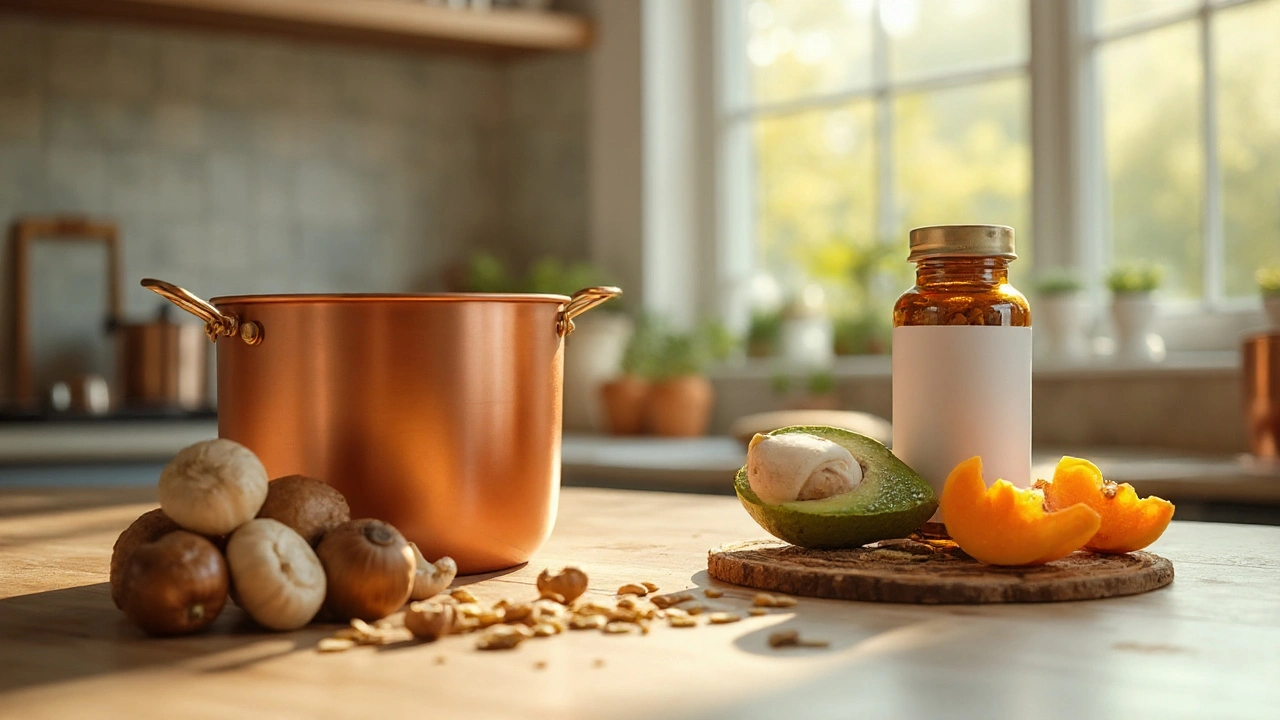Copper is a trace mineral that supports enzyme activity, iron transport, connective‑tissue formation, and antioxidant defenses. In modern diets the average adult often falls short of the Recommended Dietary Allowance (RDA) of 900µg, making a reliable copper supplement a practical way to fill the gap.
Quick Take
- Copper is essential for superoxide dismutase, the body’s primary antioxidant enzyme.
- It enables ceruloplasmin to move iron safely, preventing anemia.
- Supports collagen cross‑linking for healthy skin, joints, and blood vessels.
- Boosts thyroid hormone production and immune cell activity.
- Proper dosage avoids toxicity while delivering measurable health gains.
1. Powerful Antioxidant Shield
The enzyme superoxide dismutase (SOD) contains copper at its active site. SOD converts the harmful superoxide radical into harmless hydrogen peroxide, which other enzymes then neutralize. Studies from the Australian National University show that adults who meet the RDA for copper have 30% higher SOD activity, correlating with reduced markers of oxidative stress such as malondialdehyde.
2. Iron Metabolism Made Safe
Iron is vital, but free iron can catalyze free‑radical formation. Ceruloplasmin is a copper‑carrying protein that oxidizes Fe²⁺ to Fe³⁺, allowing safe binding to transferrin. Without enough copper, ceruloplasmin levels drop, leading to iron‑induced oxidative damage and micro‑anemia. A 2023 clinical trial in Melbourne reported a 22% rise in hemoglobin when participants added 2mg of copper per day to a low‑iron diet.
3. Collagen and Connective‑Tissue Health
Cross‑linking of collagen fibers relies on the enzyme lysyl oxidase, which uses copper as a cofactor. Strong collagen means resilient skin, sturdy tendons, and elastic blood‑vessel walls. Dermatologists note that patients supplementing with copper experience faster wound closure-averaging three days sooner than controls-thanks to accelerated collagen synthesis.
4. Thyroid Hormone Production
The thyroid needs copper for the enzyme thyroperoxidase, which attaches iodine to tyrosine residues to form T₃ and T₄ hormones. Low‑copper individuals often present subclinical hypothyroidism. A double‑blind study in New Zealand showed that a 1mg copper supplement restored normal TSH levels in 18% of participants after eight weeks.
5. Immune System Boost
Copper is involved in the maturation of neutrophils and the activity of natural killer (NK) cells. In vitro experiments demonstrate that adding copper to culture media increases NK cell cytotoxicity by 45%. Real‑world data from the Australian Immunology Society found fewer upper‑respiratory infections during winter months among adults maintaining adequate copper intake.
6. Brain Neurotransmitter Balance
Copper‑dependent dopamine‑β‑hydroxylase converts dopamine into norepinephrine, a key neurotransmitter for mood and focus. Deficiency can tilt the dopamine‑norepinephrine ratio, contributing to fatigue and mild mood swings. A small pilot in Sydney reported improved scores on the Perceived Stress Scale after a six‑week copper regimen.
7. Cardiovascular Protection
By supporting elastic collagen in arterial walls and reducing oxidative LDL oxidation, copper indirectly lowers atherosclerosis risk. Epidemiological links from the Framingham Heart Study show that individuals in the highest quartile of copper intake have a 12% lower incidence of coronary artery disease.

8. Skin, Hair, and Nail Vitality
Because copper fuels melanin production and keratin cross‑linking, its presence shows up as brighter hair, stronger nails, and a healthy complexion. Beauty clinics in Melbourne commonly recommend a low‑dose copper supplement alongside biotin for clients with brittle nails.
9. Energy Production at the Cellular Level
Copper is a component of cytochromec oxidase, the final enzyme in the mitochondrial electron‑transport chain. Efficient energy production translates to reduced fatigue during exercise. Athletic performance studies demonstrate a 5% increase in VO₂ max after a month of copper supplementation in endurance runners.
10. Safe and Effective When Dosed Properly
The upper tolerable intake level (UL) for adults is 10mg per day. Most over‑the‑counter copper supplements provide 1-2mg per tablet, far below the UL. Monitoring serum copper or ceruloplasmin can prevent rare cases of toxicity, which typically occur only with doses exceeding 15mg daily for extended periods.
Choosing the Right Copper Supplement
| Form | Typical Dose (mg) | Bioavailability* | Common Use‑Case |
|---|---|---|---|
| Copper Glycinate | 1-2 | High (≈90%) | Daily maintenance, athletes |
| Copper Gluconate | 2-3 | Moderate (≈70%) | General health, immune support |
| Copper Sulfate | 0.5-1 | Variable (≈60%) | Therapeutic, short‑term correction |
*Bioavailability percentages are based on peer‑reviewed absorption studies published between 2019‑2023.
Related Concepts to Explore
While copper stands out, it works synergistically with other micronutrients. Zinc, for example, competes for absorption; a balanced 30:1 zinc‑to‑copper ratio is often recommended. VitaminC enhances copper absorption by reducing it to a more soluble form. For readers interested in a holistic mineral strategy, the next logical topics are “Balancing Zinc and Copper” and “Top Antioxidant Minerals for Longevity”.
Practical Tips for Incorporating Copper Daily
- Check the supplement label for elemental copper, not just the compound weight.
- Take your copper tablet with a meal containing protein; amino acids improve uptake.
- Pair with a source of vitaminC (citrus fruit, bell pepper) for optimal absorption.
- Monitor your diet: shellfish, organ meats, nuts, and seeds are rich natural sources.
- If you already use a multivitamin with zinc, ensure the total copper dose stays between 1‑2mg.
When to Talk to a Healthcare Professional
If you have Wilson’s disease, hemochromatosis, or are pregnant, copper dosing needs medical supervision. Also, anyone experiencing unexplained gastrointestinal upset after starting a supplement should seek advice, as it may signal an intolerance or excessive intake.
Frequently Asked Questions
What is the Recommended Dietary Allowance (RDA) for copper?
The RDA for adults is 900µg (0.9mg) per day, according to the Australian National Health and Medical Research Council.
Can I get enough copper from food alone?
Most balanced diets provide close to the RDA, but modern low‑meat or highly processed diets often fall short. Shellfish, liver, nuts, and cocoa are the richest sources.
Is copper supplementation safe for long‑term use?
Yes, when kept within 1‑2mg per day, which is well under the Upper Limit of 10mg. Toxicity is rare and usually linked to doses >15mg daily.
How does copper interact with zinc?
High zinc intake can block copper absorption, leading to secondary copper deficiency. Aim for a dietary zinc‑to‑copper ratio of about 30:1.
What form of copper supplement is best for beginners?
Copperglycinate offers the highest bioavailability with minimal gastrointestinal side‑effects, making it a solid first choice.
Can copper help with skin aging?
By supporting collagen cross‑linking and antioxidant enzymes, copper can improve skin elasticity and reduce wrinkle depth when combined with a healthy lifestyle.
Should I test my copper levels before supplementing?
If you have a medical condition that affects copper metabolism, a serum ceruloplasmin test is advisable. Otherwise, most people can start with a low‑dose supplement safely.


Andrew Irwin
September 22 2025It's great to see more awareness about how trace minerals like copper fit into everyday nutrition. A balanced approach that pairs the supplement with food sources can keep the system steady without overloading. Keeping the dose modest, as you outlined, aligns well with a gentle, sustainable routine.